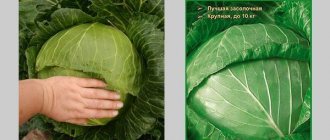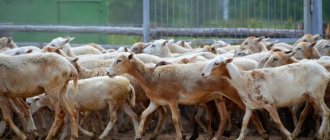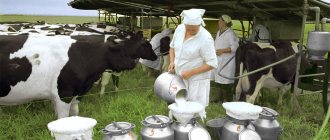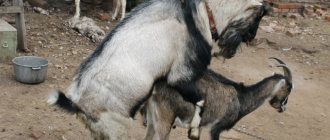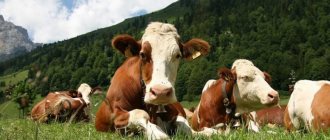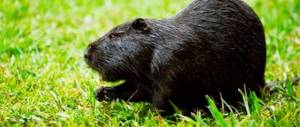Who is given the pumpkin?
The fodder variety of pumpkin is considered a technical vegetable. It differs in size and appearance, but sowing is carried out in the same time frame as for table crops.
The main purpose is feeding farm animals, so the choice of variety depends on the required amount of harvest.
The product is added to the diet of pigs, cows and chickens. It ensures weight gain and introduces essential vitamins and microelements into the diet. But you can’t feed animals only this: excess fiber leads to digestive disorders.
In addition to livestock, this vegetable is useful
The best varieties
Pumpkin silage.jpg 90w, https://pro100ogorod.ru/wp-content/uploads/2019/03/polivat3-300×225.jpg 300w" sizes="(max-width: 600px) 100vw, 600px" /> For pumpkins are easy to care for
Among those there are popular types. They are unpretentious in care and produce a high yield in a private garden. These include:
- A hundred pound. An unpretentious variety that grows throughout Russia. Late ripening. Large-fruited species - size depends on care. Loves warmth. Color orange or yellow. Average weight – 9 kg. The pulp is moderately sweet, if
Other options
/li>
- Nut. Versatile, with a lot of seeds inside. The pulp is loose with a neutral taste. It responds well to organic fertilizers and produces a harvest by the end of summer. It has a long shelf life.
- Hybrid 72. Large-fruited mid-season variety. The bush is distinguished by long vines and powerful foliage. The fruits are round, spherical in shape. The weight of one vegetable is from 6 to 9 kg. The pulp is yellow, loose. Vegetable n
The best pumpkin varieties for open ground
Pumpkin is rightfully considered one of the most delicious and healthy vegetable crops. Moreover, it is equally tasty both fresh and boiled, fried and baked. Pumpkin contains a large amount of substances and vitamins necessary for the human body, so it should grow on every gardener’s plot. People love pumpkin in different regions of Russia, and this gives reason to take into account the climatic characteristics of each area. The amount of harvest a farmer can count on depends on the growing conditions.
Read also: The best kind of beer
The best pumpkin varieties for open ground
Contents of step-by-step instructions:
Price for fodder pumpkin
quantity.
The maximum daily dose is about 19 kg. They also mix the puree with legumes: the combination helps to prolong the feeling of fullness in pigs or cattle. Complementary feeding begins at six months of age.
On average, vegetables account for 30% of the diet weight. The weight gain with a balanced diet with the addition of purees is about 900 g per day.
Pumpkin ensiling
Ensilage is a simple process that allows you to preserve useful components for animals in
It is carried out with healthy and affordable ingredients. What to add to silage:
- leaves (tops);
- flour;
- hay;
- legumes
The percentage of the main component must be at least 60. The main raw material is cut or grated, placed in dense containers and closed.
But in the silage the carotene content is reduced to 20 mg. If mixed with legumes, maintain a proportion of 70% legumes and 30% vegetable mass. Such a bookmark must be sealed.
The danger of this method is that if stored improperly, the pumpkin may rot or become moldy. Use only sterile containers and store the product for no more than 2 months.
Other options
To make a pet's diet correct, use boiled, raw and even dry pumpkin. Heat treatment does not affect the composition.
If you plan to fight helminths, use ground seeds. Meal is also useful for prevention.
- Dogs are given pumpkin porridge with rice and herbs.
- Stewed pumpkin with zucchini is suitable for feeding cats.
Dried is added to ready-made food or to porridge during cooking. Frozen pulp does not lose useful components.
Pumpkin powder is a beneficial option for pets who are sick in the winter. It is made from portioned dry pulp, grinding in a coffee grinder. Store in a metal container.
[dzs_videogallery]
Moscow region and Middle Zone
For these areas there are also varieties of pumpkin that survive best in these climatic conditions.
Medicinal pumpkin. Description of the variety
A characteristic feature of this pumpkin is its slightly flattened shape; it is always easily recognizable among other fruits. Farmers greatly value Medicinal pumpkin for its excellent taste, rich smell, bright color, and also for its practical quality - early ripening (about three months). Externally, a pumpkin is easy to recognize not only by its specific shape, but also by the gray-green color of the skin with a unique pattern.
Another excellent early-ripening variety is the Healing pumpkin, which, like its other “brothers,” has excellent taste. Oval orange fruits without a pattern have juicy pulp. The weight of one fruit is from 2.5 to 3 kilograms. Pumpkin can easily be stored for 6 months without loss of taste.
If you want to get a harvest in August, then this variety of pumpkin should be planted in June. It is important to choose well-drained soil and, preferably, a sunny place. This pumpkin loves water, so it’s better not to skimp on watering. Experts advise mulching the holes with peat, which will prevent rapid evaporation of water.
Sweet pie
Pumpkin "Sweet Pie"
The variety with a tasty name is early ripening, that is, it will take about 3 months for the fruits, the average weight of which is from 2 to 3 kilograms, to ripen. Among the features of pumpkin is its crispy and very tasty pulp, which is excellent for canning. Farmers love this variety for its high and stable yield, but for this they need to provide it with proper care: regular watering, fertilizing, loosening and weeding. Sweet pie is ideally sown in conditions when the soil reaches a temperature of 12 degrees.
Read also: The best variety of watercress
Candied fruit is a variety characterized by high yield and rapid ripening (from 112 to 118 days). The fruits will be quite large - about 2 kilograms, so you need to sow the seeds with this in mind. The pulp of the candied pumpkin variety is very tasty - juicy, crispy and aromatic.
Large-fruited pumpkin “Candied fruit”
Farmers recommend planting Tsukat on sandy loam and light loamy soil, since this is where the variety produces the richest harvest. After planting, you need to wait for the first shoots and remove weak plants, and water the remaining ones abundantly, weed, pinch and feed.
If you want a multi-purpose pumpkin, then Premiere is the perfect option. Add to this the early ripening of the variety and high yield, and you will no longer look for other varieties of pumpkin. As a result, farmers receive large, smooth fruits with a high content of sugar, carotene and dry matter.
You need to sow the seeds at a time when the threat of frost has completely passed, that is, not earlier than the end of May - beginning of June. In order for the resulting fruits to be large and ripen quickly, you need to leave from 2 to 4 fruits on one bush. The premiere is kept quite well.
Gribovskaya winter
Large-fruited winter pumpkin "Gribovskaya"
Unlike other varieties described above, Gribovskaya Zimnaya belongs to the late-ripening varieties - the fruit ripening period ranges from 128 to 140 days. However, the plant is quite productive. The weight of one pumpkin ranges from 3 to 7 kg. Other advantages include good transportability and the possibility of long-term storage.
Gribovskaya bush 189
Gribovskaya bush 189
This pumpkin variety is known for its unusual egg-shaped fruit. A ripe pumpkin has a light orange hue, ornately decorated with greenish patterns. The fruits taste very tasty - sweet and juicy, and are also quite large - about 5 kilograms. They are characterized by high transportability and good shelf life.
Experienced farmers assure you: you need to sow the seeds of the variety in late May - early June.
Pumpkin Gribovskaya Bush 189
The dacha variety is rightfully considered one of the fastest ripening - within 70 days after germination there will be the first harvest. The fruits are oval or ovoid, and the color is yellow and only the stripes have a dark green tint. This variety of pumpkin is very sweet and juicy. The average weight of one fruit is about 3 kg.
Among the main advantages of the variety, farmers note its high yield, early ripening, and resistance to cold. To get a good result, you need to sow a pumpkin only when the ground warms up to at least 10 degrees. It is very important to water, weed and hill the plant in a timely manner.
Can it be eaten by humans?
Technical varieties can be eaten by both animals and people. But this subspecies is not as tasty as the table variety, but no less healthy. It is better to prepare the pulp before consuming it so that it becomes sweeter and has a pleasant structure:
- To reduce the amount of moisture, the pulp can be boiled and drained in a colander. If you use syrup instead of water, you can increase the sweetness.
- It is better not to use (not consume) forage varieties for dietary nutrition. It will be difficult to accustom a child to tasteless technical grade complementary foods.
- The composition and taste of a vegetable directly depends on its type. Therefore, one should not expect high culinary properties from purely forage crops.
Edibility
Some varieties of fodder pumpkins are eaten
Special cultivated varieties are most widespread in cooking. Pumpkin, due to its unique taste, is not so popular among people. However, some of its varieties, for example Volzhskaya gray 92, are acceptable for consumption.
For many years, this vegetable was eaten only by peasants. The townspeople and those who considered themselves wealthy did not eat it.
On the American continent, this product was eaten by people who were considered the most backward - the Indians. However, as a result of food problems, they began to treat it differently.
And today pumpkin is one of the most beloved dishes of Americans. No Thanksgiving is complete without it. Entire fields are sown with this vegetable just for use at Halloween.
Not only the pulp is the edible part of the fruit. Almost all parts of the vegetable have nutritional value: flowers, leaves, seeds, stems. All parts of the plant contain vitamins A, C, as well as iron and calcium. They are boiled, fried, baked. Flowers can even be consumed raw.
Particular preference is given to seeds. They are eaten raw, dried and fried. The pulp contains many nutrients, setting records among many vegetables. There is 5 times more carotene in pumpkin, which is responsible for clarity of vision, than in carrots.
By adding vitamin E to it (oil, dried apricots, seeds), we get a tasty cure for cancer that will improve the quality of the skin, balance hormonal levels and reduce the symptoms of menopause. Due to its low calorie content, obese people include it in their diet.
The vegetable has many advantages, but there are also disadvantages. This variety is contraindicated for those who have an active stage of diseases of the gastrointestinal tract, pancreas, and liver.
If you have an upset stomach, you should also not eat this vegetable. People with severe diabetes are not allowed to eat pumpkin raw.
